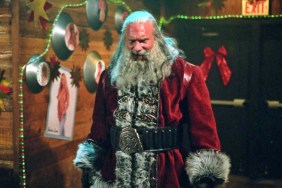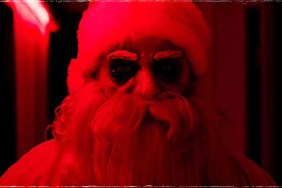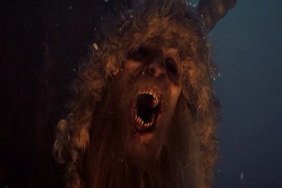
He sits in the mall and waits for a line of children to sit in his lap, asking each if they’ve been “good little boys and girls,” his white beard accented by rosy red cheeks. Then — after everyone has fallen asleep late that night — he sneaks into their houses via the chimney and delivers presents to only those he deems to have been well behaved all year long. The rest get coal in their stockings; a blunt reminder that they need to shape up, as Kris Kringle is always watching. In short, Santa Claus is kind of a sick dude, taking stock of the world’s youth like some kind of leering, judgmental pederast. Yet we revere this Biblical myth because (like most of our traditions) pop culture has morphed him into a jolly caricature, robbing Saint Nick of his Byzantine roots as a 4th-Century, dowry-delivering Greek Christian bishop who saved impoverished daughters from becoming prostitutes.
Most of this spiritual whitewashing is due in part to Clement Clarke Moore. According to legend, Moore composed the poem “A Visit From St. Nicholas” during a wintry, sleigh-bound shopping trip in 1823. Political cartoonist and scourge of the Tammany Hall political machine that ruled NYC with an iron fist, Thomas “Nasty” Nast, is responsible not only for the Elephant symbol that came to represent the modern Republican party, but also the accepted image of Santa Claus being a jolly, bearded fat man. Moore and Nast’s works combined and snaked their way into the public consciousness, creating a collective mental representation of St. Nick for the American people. Yet it wouldn’t be until 1934, when John Frederick Coots and Haven Gillespie’s “Santa Claus is Coming to Town” played on Eddie Cantor’s NBC radio show, that the peeping persona would be cemented in the hearts and minds of children everywhere. “He sees you when you’re sleeping, he knows when you’re awake,” Cantor crooned over the airwaves, “He knows when you’ve been bad or good, so be good for goodness’ sake!” If you ignore the obvious earworm the song’s become, one could almost imagine Crazy Ralph from Friday the 13th maniacally grinning at a group of youngsters while hissing these words. It’s a dire warning, transmorphed into a yuletide jingle that, upon first public rendition, went on to immediately sell 400,000 copies of sheet music by Christmas that year.
Horror comics are the medium that would finally recognize the nefarious nature of Santa Claus’ late night deliveries. In 1954’s February/March issue of The Vault of Horror (#35, to be exact), the suit of St. Nick is donned by an escaped mental patient. Menacing a murderous housewife, the issue revolves around a cat and mouse game that develops between the two sociopaths. No longer was Santa Claus a welcome guest, but a raging lunatic hell-bent on murdering the woman for no good reason. EC Comics creators William Gaines and Al Feldstein had subverted the yuletide icon, as artist/writer Johnny Craig ascended to editor at the legendary funny book house with this classic issue.
However, no generation would completely tarnish the red suit quite like the horror pictures of the 70s and 80s. After John Carpenter’s Halloween, nearly every low budget filmmaker the world over wanted a holiday of their own to terrorize (despite Bob Clark’s Black Christmas pre-dating the “most profitable independent movie of all time” by the better half of a decade). A bloodthirsty miner would stalk teens into the depths in My Bloody Valentine. The FM airwaves wouldn’t be safe in New Year’s Evil. Thanksgiving would throw an unstable young man into a Blood Rage. It was only logical that one of these low budget moneymen would look to demonize jolly ol’ St. Nick. Unfortunately, few of these pictures would even turn a profit, while one would inspire protests that would eventually lead to the picture’s yanking from theaters by its distributor. “What’s next, the Easter Bunny as a child molester?” Leonard Maltin (the veritable Mr. Rogers of popular film criticism) would ask. Because people don’t like their safety being undermined. Despite the fact that there’s a noticeable spike in suicides every holiday season (as Phoebe Cates would so memorably point out in Gremlins), Christmas represents the “most wonderful time of the year” for almost all. Yet these five films dare to sneak into the chimneys of safe suburban homes and invade minds, reminding us that even Kris Kringle could yield a fire axe with the best of ’em.

Otherwise a rather drab affair, Freddie Francis’ 1972 Amicus anthology film contains a direct adaptation of the aforementioned EC Comics short “And All Though the House” thats poppy and vibrant. Translating the three-color panels near word-for-word to the big screen, Francis (who would later go on to become a semi-regular cinematographer for David Lynch) evokes the plasticity of 70s pastels. The interior of the home of a rich, murdering wife (Joan Collins) screams at you, as if the pages had originally been written eighteen years after 1954. Robert Zemeckis would later pull the same trick, transforming “And All Through the House” into the second episode for the landmark eponymous HBO series. But what makes the story so damn popular, twenty years on?
The easy answer is that both versions reduce Santa to a human maniac. A radio tells the woman that a madman has escaped capture and is looking to menace anyone he can. How to spot this human pile of crazy? He’s stolen a red Santa suit from a nearby store. In Francis’ decidedly more British version, Oliver MacGreevy lurks outside, his face smeared with dirt and grease. Meanwhile, the newly self-made widow tries to lock him out as she simultaneously keeps an eye on her daughter’s bedroom, where she hopes the girl is safely asleep. In Zemeckis’ version, Larry Drake is the cartoonish murderer — bug-eyed and completely manic. Granted, Zemeckis and screenwriter Fred Dekker (The Monster Squad) had significantly more time to play with both characters than Francis’ original film (the ’72 segment runs about ten minutes long while Zemeckis’ is a full half-hour). Keeping with the true Tales From the Crypt spirit, both end on a rather ironic note that also reminds us of one thing: though the eyes of a child, Santa will always be a gentle giver. It isn’t until we grow up that we realize he’s an utter menace to society.

To All a Goodnight [1980] (d. David Hess, w. Alex Rebar)
In his only feature length directorial effort, David Hess (best known for his hyper-rapey work in Wes Craven’s Last House on the Left) proves not only does he know his way around playing a sleaze, he’s quite adept at crafting a solid work in his own wheelhouse. Ostensibly a standard slasher, Hess is nevertheless a natural at recognizing what fans of the sub-genre respond to viscerally. Most importantly, he’d be the first to transform Santa Claus into a Michael Myers-esque psychopath with his film, four years before the picture that is often credited for doing so.
If we’re being completely honest, To All a Goodnight feels like a cheapie, Italian knockoff of Bob Clark’s seminal Canadian Halloween precursor, BlackChristmas. In the context of David Hess’ career, this actually makes perfect sense, having shot Hitch–Hikewith Pasquale Festa Campanile in 1976 and House On the Edge of the Park with notorious Cannibal Holocaust director Ruggero Deodato in 1979, the same year he’d make To All a Goodnight in a mere ten days. The problem with both this frugal and fast production style and Hess’ obvious knowledge of the genre is that Santa Claus is relegated to being a background player at best. The killer stalking these girls could just as easily be the fat, sweaty bespectacled beast from Brian De Palma’s Blow Out for all we care, as To All a Goodnight ends up instead being a “slasher that takes place on Christmas” instead of truly being a “Christmas Slasher”. It’s the devaluation of a cultural icon; trash cinema showing that it can bring St. Nick down into the dumpster. But the gutter attitude Hess brings to both his acting and sole directorial work is what makes it so special. To All a Goodnight is genuine sleaze; shot for nothing with the sole hope to titillate. We don’t make enough movies like that anymore.

Christmas Evil [1980] (d. & w. Lewis Jackson)
Christmas Evil (a/k/a You Better Watch Out) is the film where Santa truly became interesting…at least within the context of horror pictures. Lewis Jackson’s strange, even-flow character study of a man (future father to Fiona Apple, Brandon Moggart) who wants nothing more than to be the sole judge of his neighborhood’s children, the movie is undoubtedly disturbing while still carrying a strange saccharine streak. To the call Christmas Evil “heartwarming” wouldn’t be too far out of the line, as it arguably contains one of the greatest final shots of any Holiday film, period. Jackson turns Moggart’s sad-eyed muppet of a man into a sympathetic antihero akin to a candy cane-coated Travis Bickle. Only instead of wanting a real rain to come and wash the streets away, he’s hell-bent on ensuring that all the good boys and girls get what they deserve this Christmas, while any fornicating adults run the risk of possibly getting stabbed in the eyeball.
There’s a moment in every child’s life where they finally learn Santa Claus isn’t real. For the central figure in Jackson’s final directorial effort (after the hilariously named The Transformation: A Sandwich of Nightmares and his soft-core Deviates), it was the moment he saw mommy making out with the man in red under the mistletoe. At its core, ChristmasEvil is a movie about the death of innocence; that piercing realization when the myths made up to keep us mentally in a crib are no more. Like a snow globe dropped to the floor, the world of this soon-to-be factory toy line worker is brought down by a bit of fetishistic sexuality. But beyond our man’s haunting mental meltdown, Jackson is focused on how the world at large moves on and leaves the true goodness of Santa behind. We inevitably all become adults, focused on the shiny whatnots under the tree and how good our significant others are going to look in that slinky something we bought for them to wear once the kids are fast asleep. For Jackson, Santa represents the wonder we all lose as we get older; the magic in the December 24th moonlight that exists, whether our busy lives allow us to stop and marvel or not. And if a few bodies are dropped in service of making the peripheral characters in ChristmasEvil remember what it means to be young, they’re ultimately necessary cruelties.

Silent Night, Deadly Night [1984] (d. Charles E. Sellier, Jr., w. Michael Hickey)
The proverbial straw that broke the reindeers back, Silent Night, Deadly Night is not only one of the most controversial slashers of all time, but one of the most controversial pictures. Picketed by PTA groups, whose protests lead to the bombardment of TriStar by numerous concerned letter writing collectives, Charles E. Sellier, Jr.s story of the boy who would grow up to punish all the naughty boys and girls in his path is incredibly bleak, nasty and totally fucked up. An adaptation of Paul Caimis dime store horror novel Slay Ride (good luck finding a copy*), Silent Night, Deadly Night chronicles the abuse young Billy (played by three different actors of varying ages who couldnt look less alike) endures at the hands of carjackers, orphanage-entrusted nuns (including Lilyan Chauvin, in an all-timer screen villain role) and drunken toy store employees. Much how Rob Zombie would re-envision Michael Myers as being nothing more than a sad, battered boy who finally snapped and became a monster, Billys moment of murderous rage occurs once hes forced by his boss to dress up in Santas suit. Its essentially Trigger Warning: The Motion Picture; a cautionary tale of how the traumatized can become a barreling ball of bloodletting if pushed too far.
Ironically enough, Silent Night, Deadly Night was the movie that embraced Santas most priggish angle, as Billys murders are not too unlike that of a Jason Voorhees or any other morally strict slasher picture icon (it actually opened on the same weekend as A Nightmare on Elm Street and briefly out-grossed Cravens genre staple before TriStar pulled it from theaters). He impales a topless babysitter (Linnea Quigley) on a set of deer antlers after she fornicates with her piggish boyfriend (who is, in turn, brutally dispatched). Later, he decapitates a foul-mouthed brat after he bullies another into sledding down a treacherous suburban slope. These are the actions of a puritanical punisher, only instead of not delivering toys to bad girls and boys, he snatches their life from the planet. However, parents sought to impose their own set of values on the moviemaking world, threatening to boycott the studio if they didnt restore purity to St. Nick. The studio caved (after making its meager budget of $750,000 back) and, according to Sellier, it had nothing to do with moralistic qualms. TriStar was up for public offering and couldnt risk the price of their shares bottoming out due to bad press. Though itd be saved by LIVE Videos VHS release (and subsequent home media drops), Santa found himself at the mercy of the stockholders, all of whom didnt want his prudish rage to punish their wallets.

Producer Dick Randall was responsible for some glorious trash. Most know his name from it hovering above a giant bloody knife in the opening credits for Pieces, the most gonzo and compulsively watchable slasher movie ever made. Others will recognize the schlockmeister’s moniker from Italian erotica like Guido Zurli’s Queen of Sex or the knockoff Emmanuelle romp, Emmanuelle Goes to Cannes. Randall was a no shame master of exploitation, whose Hong Kong-incorporated movie production and sales outfit, Spectacular Trading Company Limited, dipped their toes into every sub-genre, from Mondo documentaries to giallo thrillers. Don’t Open ‘Till Christmas fits the mold of being a “Dick Randall Joint” through and through, as instead of simply creating a standard body count slasher, what results is a slaughter of Santas, each dying more gruesomely than the last. If ever there was a movie that justified Conservative pundits rallying to prevent a “War On Christmas,” Don’t Open is it; a grimy, mean-spirited piece of cinema that feels like it came from a kid who was fed up with a lifetime of coal in his stocking come December 25.
This disgruntled vibe makes Don’t Open the perfect capper to this string of Santa slashers, as it turns the tables and essentially kills off the character completely. Though surely unintentional (the movie took two years to complete after Randall and the other money men fired original director/Pieces star Edmund Purdom and his replacement, drunken soft-core screenwriter Derek Ford), its drop into theaters after the debacle surrounding Silent Night, Deadly Night and its protested release acts as a fitting coda to St. Nick’s “career” in the murder movie industry. For decades, Santa would put the axe away and return to his rightful place as a benevolent giver of gifts to children. That Randall’s picture went mostly unnoticed in the US upon initial release, playing in a handful of drive-ins and inner city dive theaters, speaks to the fact that the American public had no need to see Kris Kringle off any more naughty citizens. Don’t Open ‘Till Christmas is sleaze for sleaze’s sake, a mostly forgotten gem that, like To All a Goodnight, wears its exploitive pride unashamedly on its sleeve. Ain’t nobody got time for that in December, which leaves it up to drooling denizens of horror fans to make sure these misbegotten diamonds in the rough continue to play on to the deviants and dregs of society.
*The latest word, from Dread Central’s SNDN retrospective, is that the book doesn’t even exist
Jacob Knight is an Austin, Texas based film writer who moonlights as a clerk at Vulcan Video, one of the last great independent video stores in the US. You can find find him on Twitter @JacobQKnight.










